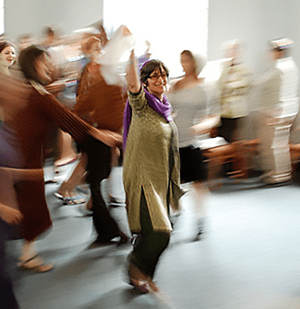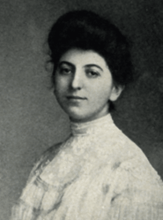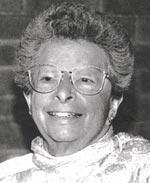Judith Brin Ingber
Judith Brin Ingber is a dancer, choreographer, writer, and dance historian who fostered the contemporary research field of Jewish dance studies. Ingber established conversations regarding how dance is a Jewish cultural phenomenon. In so doing, she fostered multiple generations of Jewish dance researchers, students, dancers, and writers. Throughout her career, Ingber questioned why certain dance forms are celebrated while others are marginalized; this pursuit led to Ingber’s vast work broadly and deeply performing and writing about Jewish dance in all its forms. This entry covers Ingber’s family lineage, her training in dance and journalism, her work in Israel in the 1970s with Gertrud Kraus and with the Bat Dor Batsheva Dance Society, her work in Minnesota with Voices of Sepharad, and her publications.
Judith Brin Ingber is a dancer, choreographer, writer, and dance historian who cultivated the contemporary research field of Jewish dance studies. By establishing space for conversations regarding how dance is a Jewish cultural phenomenon, Ingber became a foremost expert on Jewish dance and dancers around the world. She has fostered multiple generations of Jewish dance researchers as well as countless students, dancers, and writers.
Family History and Early Dance Training
Ingber was born in Los Angeles on November 5, 1945, to a Reconstructionist Jewish Zionist family and grew up in Minneapolis, Minnesota. She is the daughter of liturgical pioneer Ruth F. Brin and businessman Howard Brin, and granddaughter of suffragist and National Council of Jewish Women President Fanny Fligelman Brin. She has three siblings: Aaron Brin, an organic farmer; David Brin, a musician; and Rabbi Deborah Brin, one of the first 100 ordained women rabbis in the United States and one of the first lesbian rabbis on record. Judith’s husband, Jerome Ingber, was an immigration lawyer; their children are Shai, a lawyer, and Noah, an elementary school principal.
Ingber’s grandmothers, both suffragists, fostered her dancing. Ingber’s maternal grandmother took her to a performance at the University of Minnesota at the age of three, which inspired Ingber’s love of dance. Ingber insisted on dance lessons, which began at age four in a Minneapolis dance studio with a full menu of dance styles. While in elementary school, Ingber regularly visited her paternal grandmother, who lived nearby on the Lake of the Isles. Ingber’s earliest memories of making dances were improvising for her grandmother, who was then largely immobile from Parkinson’s disease, to recordings of composers including Satie and Stravinsky.
At age seven Ingber enrolled in the Andahazy ballet studio run by Lorand Andahazy and Anna Adrianova, where Ingber studied through high school. The couple deeply influenced her dance worldview. Andahazy was born in Hungary and came to the US as a refugee; Adrianova was born Shirley Bridge and was the first American in the Ballet Russe de Monte Carlo. The pair toured with the company throughout Europe, the US, and Australia. In high school, Ingber was cast in the Andahazy Ballet Borealis production of Scheherazade; George Zorich, a dancer with the Ballet Russe de Monte Carlo, was working with the Andahazys at the time and helped to stage the production.
Discovering Dance Writing and Professional Dance in College
Ingber majored in dance at Sarah Lawrence College in New York. There, she studied with legendary choreography teacher Bessie Schönberg along with a host of prominent dancers from the mid-twentieth century New York dance scene: Judy Dunn and Viola Farber, who taught Merce Cunningham’s technique; Don Redlich, who taught Hanya Holm’s technique; and Remy Charlip, a Cunningham dancer who specialized in children’s theater. Many of Ingber’s classmates also went on to be prominent choreographers and dancers, including interdisciplinary artist Meredith Monk, in whose work Juice Ingber performed at the Guggenheim Museum in 1969. Ingber regularly took the train from campus into Manhattan to study at Martha Graham’s studio. Her Graham training later supported her entry into the world of the Batsheva Dance Company, which was then based in Graham’s work.
Two events during Ingber’s college years defined her career: 1) she was published in Dance Magazine; and 2) she met prominent Jewish dancer Fred Berk. While home in Minnesota during a semester-long leave due to a severe knee injury, Ingber wrote an editorial about her frustrations with the fracturing she saw in the Minneapolis dance scene between ballet and modern dance practitioners. Dance Magazine published her open letter “Don’t Splinter the Dance: A Sarah Lawrence Dance Major Takes a Look at Dance in Minneapolis” in August 1965, launching her career as a dance writer. The egalitarianism Ingber espoused in this foray into dance publishing, wherein she questioned why certain dance forms are heralded while others are marginalized, has continued in her writing through her career. When she graduated from Sarah Lawrence in 1967, Ingber went to work at Dance Magazine as editorial assistant to Chief Editor Lydia Joel and to critic and Senior Advising Editor Doris Hering. Ingber wrote for Dance Magazine for many years, continuing as a correspondent after she left New York.
During Ingber’s senior year at Sarah Lawrence, Schönberg invited Berk to teach a master class. Berk had danced with prominent European expressionist choreographer Gertrud Kraus in Vienna, escaped the Holocaust via Cuba, and become a leading dancer and writer about Jewish dance, based primarily in New York. He invited Ingber to take his class at the Upper East Side’s 92nd Street YM/YWHA on scholarship; she continued dancing with him. Years later, after he retired to Israel, he became a close family friend and asked Ingber to write his biography. The result was Victory Dances, Ingber’s definitive biography of Berk published by the Dance Library of Israel in 1985.
Life and Work in Israel
When the Ingbers moved to Israel in 1972, Judith immersed herself in the dance scene. Judith had met her husband in December 1970 through her sister’s introduction (Jerome and Deborah were in a Hebrew class together), and they married in 1971. Judith already had plans to go to Israel to pursue a dance career, and Jerome was able to get a position with the Canadian embassy in Tel Aviv. After meeting Kraus (by then an honored Israeli dance personality) during the intermission of a Batsheva Dance Company performance and identifying herself as dancing with Berk, Ingber became Kraus’s confidant and Kraus Ingber’s mentor. They met every week for coffee, and their conversations were the basis for Ingber’s March 1976 Dance Magazine essay “The Gamine Speaks: Conversations with Gertrud Kraus.” Through Kraus, Ingber met and wrote the histories of countless dancers who are considered founding members of the Israeli contemporary and folk dance scenes, including Yardena Cohen, Lea Bergstein, Gurit Kadman, Sara Levi-Tanai, and Rivka Sturman.
In Tel Aviv, Ingber taught dance technique for the Bat Dor Batsheva Dance Society studios and choreographic composition classes for apprentices in the Batsheva and Bat Dor Dance Companies. She choreographed the twenty-minute work The Language of Dance for Batsheva. Ingber counts many prominent Israeli choreographers among her students, including Zvi Gotheiner and Ohad Naharin. By 1973, she became Levi-Tanai’s assistant at Inbal Dance Theater, also working with Inbal manager Gila Toledano. In 1975, Ingber co-founded and co-edited the bilingual (English and Hebrew) journal Israel Dance Annual with Giora Manor. Ingber maintained a presence in Israel even after she moved back to the United States in 1977. She kept close professional and personal friendships with Manor; Levi-Tanai; dancer and choreographer Margalit Oved; Kraus; dancer, choreographer, and dance historian Ruth Eshel; and writer, performance artist, and dance historian Gaby Aldor.
Back to Minnesota and Voices of Sepharad
When they returned to the United States, Ingber and her family settled in Minnesota. She founded the dance program at the University of Minnesota in 1986 when it combined to become the Department of Theater Arts and Dance, and taught there for many years. Ingber continued to write often for Dance Today: The Dance Magazine of Israel, and she still writes about dance on her regular trips to Israel, often during the annual International Exposure dance festival.
In the 1980s, Ingber became invested in making Sephardic performance practices more present in Jewish arts discourse. She formed the chamber group Voices of Sepharad with singer David Harris in 1980; they toured throughout the US and Canada. Ingber choreographed and performed dances based on Harris’s singing of Ladino songs. Together they researched Sephardic forms, also investigating biblical stories with Sephardic Nusach (chant), accompanied by their drummer and ‘ud player. This work resulted in essays focused on Sephardic dance, including Ingber’s 2005 piece “Is Sephardic Dance Too Sexy?” which described historic Sephardic dance practices and their marginalization by Ashkenazi culture brokers; and her introduction to her 2011 anthology Seeing Israeli and Jewish Dance, “Coming into Focus,” which highlights North African, Greek, and Turkish Jewish dance sources as part of defining Jewish dance aesthetics.
Significant Scholarly Contributions
Ingber’s contributions to Jewish dance as a mode of cultural inquiry include her work in monographs, journals, periodicals, edited volumes, academic papers, and public lectures teaching diverse audiences how dance is an expression of Judaism and Jewish culture. Ingber’s scholarly publishing credits include: Victory Dances; “Shorashim: The Roots of Israeli Folk Dance,” a Dance Perspectives monograph from 1974; a Fall 1985/Spring 1986 special issue of Dance Research Journal titled “Dancing into Marriage: Jewish Wedding Dances” based on collected papers from a conference she directed that focused on dance traditions in Ashkenazi, Yemenite, and Persian Jewish communities; and Seeing Israeli and Jewish Dance (2011), an anthology containing essays highlighting theatrical and folk Jewish dance traditions from many parts of the Jewish diaspora.
One of Ingber’s most poignant essays is “Vilified or Glorified? Nazi versus Zionist Views of the Jewish Body,” first published in the volume of Jewish Folklore and Ethnology Review (2000) that she edited, then expanded in Seeing Israeli and Jewish Dance. In it, Ingber explains how, when folk dancers from the Yishuv toured to displaced persons camps to perform for Holocaust survivors in the aftermath of World War II, these two groups did not recognize each other as Jews across their corporeal divides, between the healthy bodies of the dancers from the Yishuv and the depleted bodies of the Holocaust survivors. As with her first editorial that asked why Minneapolis dancers would not get along, Ingber’s sustained focus on how we understand the Other through dance prompts us to reexamine our own assumptions on the stage and on the page.
Judith Brin Ingber’s papers are located in the archives of the University of Minnesota and the Dance Library of Israel. A full list of Ingber’s publications is available at: http://www.jbriningber.com/bibliography.html
Selected Works by Judith Brin Ingber
“Shorashim: The Roots of Israeli Folk Dance.” Dance Perspectives 59 (Autumn 1974): 1–60.
Victory Dances: The Story of Fred Berk, A Modern Dance Jewish Dancing Master. Tel Aviv: Israel Dance Library, 1985.
“Dancing into Marriage: Jewish Wedding Dances” Special Issue, Dance Research Journal 17/18 (Fall 1985/Spring 1986).
“Jewish Dance,” Special Issue, Jewish Folklore and Ethnology Review 20, nos. 1–2 (2000).
“Is Sephardic Dance Too Sexy?” In Sephardic Identity: Essays on a Vanishing Jewish Culture, edited by George K. Zucker, 167–177. Jefferson, NC: McFarland & Co., Publishers, 2005.
Seeing Israeli and Jewish Dance. Detroit: Wayne State University Press, 2011.
Ingber, Judith Brin. Interview with the author. February 21, 2020.
Leaf, Justin. “Memories of Loyce: Gifts Given and Received.” Minnesota Dance Theater, February 26, 2020. https://www.mndance.org/memories-of-loyce-gifts-given-and-received






